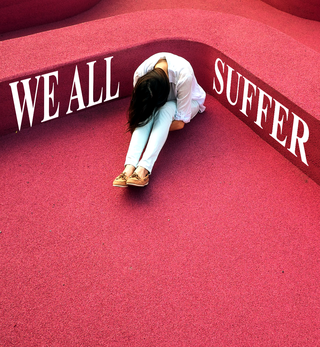Embarrassment
Shame and Compassion: Q&A With Paul Gilbert
How do shame and compassion relate to one another?
Posted February 4, 2019

Shame is a very painful experience involving complex emotions such as anxiety, anger, and disgust, and an intense sense of self as flawed or bad, with a sense of interpersonal threat of rejection or attack. Helping people who experience these shame-based emotions intensely and chronically can be very difficult, especially when these emotions seem at the core of one’s sense of self. Might compassion help in these situations?
In today’s post, I have the privilege of discussing compassion (and self-compassion) with Professor Paul Gilbert.
Prof. Gilbert studies the evolutionary aspects of psychopathology,1 and has developed compassion-focused therapy to help people who experience shame and self-criticism.2 He is Professor of Clinical Psychology at the University of Derby, and visiting professor at the University of Queensland Australia, founder of the Compassionate Mind Foundation, and recently retired Consultant Clinical Psychologist at the Derbyshire Health Care Foundation Trust. He is a past President of the British Association for Cognitive and Behavioural Psychotherapy, a Fellow of British Psychological Society, and a recipient of the Order of the British Empire.
I became familiar with Prof. Gilbert’s work many years ago when I came across his articles on shame and compassion, and later his popular book The Compassionate Mind.3 In the second chapter of that book, he discusses an evolutionary approach to understanding the functions of our emotions, suggesting that humans have three types/functions of emotion regulation systems.
The first emotion regulation system is associated with the fight-or-flight response (e.g., running away from a criminal, or showing submission in the face of a social threat).
The second is related to emotions that help us go out and achieve things, give us positive feelings, and energize us for obtaining resources (e.g., exploring, working hard to achieve things, and enjoying success).
A third type of emotion system is linked to what is sometimes called rest and digest, to feelings of contentment; this is a very different type of positive emotion that is not energizing, but settling.
Prof. Gilbert suggests mental-health problems can arise when these emotional systems get out of balance, and can no longer regulate each other. For example, we can be too much in the threat system—constantly feeling anxious or irritated and vigilant to problems; or too much in the drive system—constantly feeling pressured to do things or achieve things. And occasionally we may feel too chilled out, and fail to get on in our lives.
So it is with a question about these aspects of ourselves that I begin the interview.
Prof. Gilbert, I remember reading about the incentive/motivation emotion regulation system right after completing a challenging level in a video game. As I read the chapter, it occurred to me how much of my life was spent attempting to achieve things—first at work and the university, and now in a game (e.g., passing levels and collecting rewards). Might the structure of our lives emphasize one emotion-regulation network over another?
Yes, I think that is a good observation. We can be highly orientated to achievement and drive for a number of reasons. One is because we live in a very competitive society that encourages us, almost from the day that we are born, to socially compare ourselves to others and to strive and achieve, and this continues through schools and career. This need for achievement is partly linked to feelings of being secure and threat-avoidant in the world. We did some studies looking at striving to avoid inferiority, and we found that individuals who were striving because they were worried about failing or being seen as inferior and rejected or left behind were particularly vulnerable to problems like depression and anxiety, whereas individuals who were striving simply for the pleasure of doing the activity were much less so.
The second aspect is that of course succeeding gives you a dopamine buzz, and over time we know that succeeding at things like video games and so forth can be slightly addictive. So, there is always that physiological aspect to the dimension of drive.
The key is recognizing that when you shift into something like the rest and digest and the soothing system you are using different physiological processes to create emotion and then you have a positive affect which is of different complexion linked to a slowing down rather than a speeding up.

As you note in The Compassionate Mind, the third emotion-regulation network is linked with being “happy with the way things are and feeling safe, not striving or wanting” (p. 24).3 First, can you explain how this system works? For instance, does the contentment/soothing system work only when the fight-or-flight and incentive/motivation networks have shut down? Does it work when we feel embarrassed, ashamed, or humiliated? And second, how does it generate feelings of compassion?
The relationship between the emotion regulation systems are interesting, and really it’s all about how these systems are balanced. As you know there are different ways in which people understand emotion. We can understand specific emotion such as anger, anxiety, joy, and so forth, or we can look at emotions in terms of their functions (what are the functions of those emotions?) So, we have emotions that are linked to activating the body into defensive actions, and these will be emotions like anger and anxiety, and we have emotions that activate the body into achieving, such as drive, reward based pleasure-based emotions. These are emotions like excitement, joy, and fun. The emotions that are linked to slowing down and contentment are primarily derived from what is called the rest and digest system. So, when animals aren’t needing to respond to threats or need to go out and find food or build shelters or procreate, they can go into states of relatively calm to literally rest and digest. This has a lot of physiological effects on things like growth hormone and body repair for example. So that rest and digest process is a really important for human well-being long-term.
With the evolution of mammalian attachment behaviour, the capacity to feel safe and have one’s needs provided for came from the parents. So, the parent was the source of regulating all three systems; they would provide what you needed in terms of food and so on, be a source of protection and dealing with threats and creating a place of safeness where infants rest and can engage in playful exploration. We also evolved to be highly social, so now some of our greatest threats are social, hence the worry about shame. Some of our greatest joys are social with our colleagues, friends and lovers, and the rest and digest system became adapted to be regulated via social relationships, particularly those associated with a sense of caring. So, when you ask the question ‘does the soothing system only work when the others shut down?’ the answer would be ‘no’ because these systems are designed to work in terms of patterns. For example, if you think of playfulness, playfulness would be a way in which there was a degree of drive and pleasure and excitement but also a sense of safeness and so forth. In play we are not necessarily trying to achieve anything; we are often just exploring the environment. So, it is important to think of the rest and digest system as a contentment system, that you are happy with the way things are.
When we feel embarrassed, ashamed or humiliated, these emotions are primarily threat-based emotions and with a lack of social safeness. So, while anxiety and anger can be linked to the non-social ecology (heights, predators, getting sick), they are also related to the social environment as well of course. Shame, embarrassment, humiliations can only be experienced in the context of a social audience or an anticipated social audience.
The second is ‘how does the soothing system generate compassion?’ Well that is a great question because it doesn’t; compassion is a motivational system that is separate from the emotion system of soothing. So, we make a big distinction between motives and emotions. Motives are the processes that guide you and make things important to you. Without a motive you wouldn’t have emotions. For example, people who are dedicated to football become very excited if England win the world cup, and mildly depressed if they lose, but if you have no interest in football it won’t make a bit of difference to your emotions. So, motives give rise to emotions. Emotions come and go, they can be short-lived, whereas motives aren’t. Motives are there over the long term in the background guiding us. For example, think about the motives in wanting to be parents, and how much that will influence what we do as a parent. So, compassion is a motive.

What distinguishes compassion evolved from caring behaviour—that all mammals show particularly to their offspring but also can show to each other—is that we have a series of new cognitive abilities that we have evolved over the last 2 million years.4 These include what we call ‘knowing awareness’, insight, empathy, reasoning. So unlike animals we can knowingly care for others, purposely work out what would be helpful to them, whereas other species engage in automatic innate caring behaviour. As far as we know, they don’t do a considerable amount of thinking and reflecting and empathizing—a little bit, but not that much. Sometimes we show helpful and compassionate behaviour because we are anxious for another or angry about injustice. What the ability for soothing does is to create an opportunity for slowdown, have rest, and really hone in on these new competencies. So, the soothing system allows you to ground yourself sufficiently so that you can become knowingly aware of suffering, apparently choosing to be empathic and compassionate.
The grounding is important when it comes to training the mind, but also note that when we come to be compassionate, the context determines the emotion. For example, imagine a firefighter going into a burning house to rescue a family. Very clearly here is a very courageous compassionate act of risking their life to save another, but their emotions won’t be one of soothing—it’ll be one of anxiety and vigilance to threat in the burning building. Somebody fighting injustice, their emotion will be anger not soothing particularly, and for someone sitting with a dying patient then that might be sadness. So, the soothing really is the way of creating a state of mind that allows you to work with the other emotions such as threat and drive, so you don’t get carried away with over-excitement and overachieving and so forth; it is a balancing system, but the actual motivation for compassion is rooted in deep motivational systems.
Part 1 of 2
If you enjoyed this portion of the interview, be sure to read the second part of the interview, in which we talk about shame, compassion, and other topics: Prof. Gilbert differentiates compassion from self-pity, empathy, sympathy, and kindness. He also explains what self-compassion looks like in practice. Last, he mentions a number of resources for people wanting to learn more about self-compassion.
References
1. Gilbert, P., & Procter, S. (2006). Compassionate mind training for people with high shame and self-criticism: Overview and pilot study of a group therapy approach. Clinical Psychology & Psychotherapy, 13, 353–379.
2. Gilbert, P. (2009). Introducing compassion-focused therapy. Advances in Psychiatric Treatment, 15, 199–208.
3. Gilbert, P. (2009). The compassionate mind: A new approach to the challenges of life. London, UK: Constable & Robinson.
4. Gilbert, P. (2014). The origins and nature of compassion focused therapy. British Journal of Clinical Psychology, 53, 6–41.




